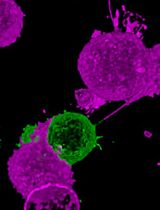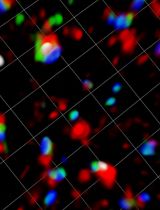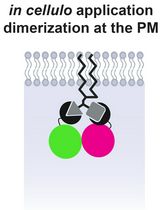- EN - English
- CN - 中文
Time-Lapse Super-Resolution Imaging and Optical Manipulation of Growth Cones in Elongating Axons and Migrating Neurons
时间分辨超分辨成像与光学操控用于研究延伸轴突和迁移神经元的生长锥
(*contributed equally to this work) 发布: 2025年03月20日第15卷第6期 DOI: 10.21769/BioProtoc.5251 浏览次数: 1670
评审: Anthony FlamierAnonymous reviewer(s)
Abstract
The growth cone is a highly motile tip structure that guides axonal elongation and directionality in differentiating neurons. Migrating immature neurons also exhibit a growth cone–like structure (GCLS) at the tip of the leading process. However, it remains unknown whether the GCLS in migrating immature neurons shares the morphological and molecular features of axonal growth cones and can thus be considered equivalent to them. Here, we describe a detailed method for time-lapse imaging and optical manipulation of growth cones using a super-resolution laser-scanning microscope. To observe growth cones in elongating axons and migrating neurons, embryonic cortical neurons and neonatal ventricular–subventricular zone (V-SVZ)-derived neurons, respectively, were transfected with plasmids encoding fluorescent protein–conjugated cytoskeletal probes and three-dimensionally cultured in Matrigel, which mimics the in vivo background. At 2–5 days in vitro, the morphology and dynamics of these growth cones and their associated cytoskeletal molecules were assessed by time-lapse super-resolution imaging. The use of photoswitchable cytoskeletal inhibitors, which can be reversibly and precisely controlled by laser illumination at two different wavelengths, revealed the spatiotemporal regulatory machinery and functional significance of growth cones in neuronal migration. Furthermore, machine learning–based methods enabled us to automatically segment growth cone morphology from elongating axons and the leading process. This protocol provides a cutting-edge methodology for studying the growth cone in developmental and regenerative neuroscience, being adaptable for various cell biology and imaging applications.
Key features
• Three-dimensional primary culture of migrating and differentiating neurons in Matrigel.
• Visualization of fine morphology and dynamics of growth cones using super-resolution imaging.
• Optical manipulation of cytoskeletal molecules in growth cones using photoswitchable inhibitors.
• Machine learning–based extraction of growth cone morphology.
Keywords: Growth cone (生长锥)Graphical overview

Background
The growth cone is a highly motile subcellular structure observed at the tip of elongating axons and involved in the determination of their directionality [1]. Since its first description by Santiago Ramón y Cajal in 1890 [2], the morphology, dynamics, and regulatory mechanisms of the axonal growth cone have been intensively studied. The growth cone consists of central and peripheral domains that are enriched with microtubule networks and filamentous actin (F-actin), respectively [3]. During the elongation process of the growth cone, F-actin polymerization first occurs at its peripheral domain to form specialized membrane protrusions such as filopodia and lamellipodia, followed by microtubule polymerization and subsequent growth cone extension [3]. These cytoskeletal dynamics in the growth cone are affected by various axonal guidance cues and extracellular matrix molecules, which ensure the appropriate projection of elongating axons [1]. Previous studies suggested that inhibition of F-actin and microtubules in the growth cone disrupts its formation and axonal elongation, suggesting that cytoskeletal dynamics in the growth cone is a central regulator for axonal elongation. Thus, time-lapse imaging of the growth cone and its associated cytoskeleton at a super-resolution level could be a potent methodology for a better understanding of its regulatory mechanisms and the establishment of novel strategies for neuronal regeneration following injury in the nervous system.
Newborn neurons are generated from neural stem cells in the embryonic and postnatal stages and show immature migratory morphology with a long leading process and a short trailing process [4]. During the migration process, these new neurons form a growth cone–like structure (GCLS) at the tip of their leading process and extend it, followed by somal translocation [5]. New neurons continue to migrate toward their final destinations by repeating these steps, which implies that the GCLS plays a central role in neuronal migration. Recent studies showed that cytoskeletal molecules in the GCLS are involved in the generation of the traction forces for efficient migration of cerebellar granule cells [6]. However, it remains unknown whether the GCLS in migrating neurons is morphologically and molecularly similar to growth cones in elongating axons.
We have recently performed comprehensive comparison analyses between growth cones in elongating axons and GCLS in migrating neurons [7]. By performing time-lapse super-resolution imaging of F-actin and microtubule dynamics, we revealed that the GCLS on the leading process of migrating neurons is morphologically and dynamically analogous to the axonal growth cone, suggesting that migrating neurons also possess a growth cone. In addition, axonal growth cone molecules were also concentrated in the leading process growth cone of migrating neurons, indicating common molecular features in axonal and leading process growth cones. Furthermore, spatiotemporal optical manipulation of cytoskeletal molecules using photoswitchable inhibitors revealed the regulatory mechanism and functional significance of the growth cone in neuronal migration. Here, we describe detailed protocols for time-lapse super-resolution imaging and optical manipulation of cytoskeletal molecules in growth cones [7]. This methodology is a basis for the fields of growth cone research in developmental and regenerative neuroscience and is also widely applicable to various types of cells in cell biology and imaging studies.
Materials and reagents
Biological materials
1. Embryonic day 15.5–16.5 (E15.5–16.5) C57BL/6J or Institute of Cancer Research (ICR) mice (Japan SLC)
2. Postnatal day 0–1 (P0–1) C57BL/6J or Institute of Cancer Research (ICR) mice (Japan SLC)
Reagents
1. Leibovitz’s L15 medium (Gibco, catalog number: 11415-064)
2. DMEM high glucose (Sigma-Aldrich, catalog number: D5796)
3. Neurobasal medium (Gibco, catalog number: 21103)
4. HBSS, no calcium, no magnesium (Thermo Fischer Scientific, catalog number: 14170112)
5. Penicillin-streptomycin (penicillin, 10,000 units/mL; streptomycin, 10,000 μg/mL) (Gibco, catalog number: 15140-122)
6. GlutaMAX (Thermo Fisher Scientific, catalog number: 35050061)
7. NeuroBrew-21 (MACS Miltenyi Biotec, catalog number: 130-093-566)
8. DNase I (1 mg/mL stock solution) (Roche, catalog number: 10-104-159-001)
9. 0.25% (w/v) trypsin 1 mmol/L EDTA·4Na solution with phenol red, 500 mL (Wako, catalog number: 201-16945)
10. RPMI-1640 medium (Wako, catalog number: 189-02145)
11. BD Matrigel matrix, 10 mL (BD Biosciences, catalog number: 354234)
12. Fetal bovine serum (FBS) (Gibco, catalog number: 10437)
13. HEPES (Sigma-Aldrich, catalog number: H0887)
14. Trypsin inhibitor from soybean (Wako, catalog number: 206-20121)
15. Bovine serum albumin (BSA) (Sigma-Aldrich, catalog number: A3059)
16. Magnesium sulfate heptahydrate (Wako, catalog number: 131-00405)
17. AmaxaTM Mouse Neuron NucleofectorTM kit (Lonza, catalog number: VPG-1001)
18. AmaxaTM P3 Primary Cell 4D-NucleofectorTM X kit L (Lonza, catalog number: V4XP-3024)
19. KE-106 (Shin-Etsu Silicone) [8]
20. CAT-RG (Shin-Etsu Silicone) [8]
21. India ink [8]
22. Opto-Latrunculin (Opto-Lat) [9]
23. Phenyl-neo-Optojasp (PnOJ) [10]
24. Photostatin-1 (PST-1) [11]
25. Dimethylsulfoxide (DMSO) (Sigma-Aldrich, catalog number: D8418-100 mL)
26. AlexaFluor 647-conjugated bovine serum albumin (2 mM) (Invitrogen, catalog number: A34785)
27. Recombinant Neurocan (Ncan) (R&D Systems, catalog number: 5800-NC-050)
28. Recombinant Syndecan-2 (Sdc2) (R&D Systems, catalog number: 6585-SD-050)
29. pCAGGS-Venus-CAAX (4.0 μg/mL stock solution) [7]
30. pCAGGS-tdTomato-CAAX (4.0 μg/mL stock solution) [7]
31. pCAGGS-DsRed-miR-lacZ (4.0 μg/mL stock solution) [7]
32. pAcGFP1-actin (GFP-actin), 4.0 μg/mL stock solution) (Clontech, catalog number: Z2453N)
33. pcDNA3.1-EB3-EGFP (4.0 μg/mL stock solution) [kind gift from K. Kaibuchi (Fujita Health University, Japan)] [12]
34. pCS2-EGFP-UtrCH (4.0 μg/mL stock solution) [kind gift from W. Bement (University of Wisconsin-Madison) and D. J. Solecki (St. Jude Children’s Research Hospital)] [13]
35. Paraformaldehyde (PFA) (Wako, catalog number: 168-20955)
36. Sodium dihydrogen phosphate dihydrate (Kanto, catalog number: 37239-00)
37. Disodium hydrogen phosphate dodecahydrate (Wako, catalog number: 198-02834)
38. Sodium chloride (Wako, catalog number: 195-01663)
39. Potassium chloride (Sigma-Aldrich, catalog number: P9541)
40. Potassium dihydrogen phosphate (Wako, catalog number: 169-04245)
41. Normal donkey serum (Sigma-Aldrich, catalog number: S30-100ML)
42. Triton X-100 (Sigma-Aldrich, catalog number: X100)
43. AlexaFluor 488-conjugated phalloidin (1:100) (Invitrogen, catalog number: A12379)
44. Anti-tyrosinated tubulin antibody (1:200) (Sigma, catalog number: MAB1864-I)
45. Anti-acetylated tubulin antibody (1:200) (Sigma, catalog number: T6793)
46. AlexaFluor 594-conjugated donkey anti-rat IgG (H+L) highly cross-absorbed secondary antibody (1:1,000) (Thermo Fisher Scientific, catalog number: A-21209)
47. AlexaFluor 647-conjugated donkey anti-mouse IgG (H+L) highly cross-absorbed secondary antibody (1:1,000) (Thermo Fisher Scientific, catalog number: A-31571)
48. Hoechst 33342 (10 mg/mL stock solution; 1:5,000) (Invitrogen, catalog number: H3570)
49. VECTASHIELD vibrance antifade mounting medium (Vector Laboratories, catalog number: H-1700)
Solutions
1. DMEM culture medium (see Recipes)
2. Dissociation buffer (see Recipes)
3. 75% Matrigel/L15 medium (see Recipes)
4. Neurobasal final medium (see Recipes)
5. 60% Matrigel/Ncan/L15 medium (see Recipes)
6. DNase I solution (see Recipes)
7. 10% FBS/L15 medium (see Recipes)
8. Sdc2/BSA-alexa647 solution (see Recipes)
9. 4% PFA in 0.1 M PB (see Recipes)
10. 1× PBS (see Recipes)
11. Blocking solution (see Recipes)
12. Silicone solution (see Recipes)
Recipes
1. DMEM culture medium
| Reagent | Final concentration | Quantity or Volume |
|---|---|---|
| DMEM high glucose | - | 10 mL |
| FBS | - | 1 mL |
| GlutaMAX (200 mM) | 2 mM | 100 μL |
| NeuroBrew-21 | 2% | 200 μL |
| Penicillin-streptomycin | 50 U/mL | 100 μL |
2. Dissociation buffer
| Reagent | Final concentration | Quantity or Volume |
|---|---|---|
| BSA | 3 mg/mL | 150 mg |
| Magnesium sulfate heptahydrate | 12 mM | 60 mg |
| DNase I | 0.025% | 12.5 mg |
| Trypsin inhibitor from soybean | 0.4 mg/mL | 20 mg |
| 1 M HEPES | 10 mM | 500 μL |
| HBSS | Fill up to 50 mL |
3. 75% Matrigel/L15 medium
| Reagent | Final concentration | Quantity or Volume |
|---|---|---|
| L15 medium | - | 25 μL |
| Matrigel | 75% | 75 μL |
4. Neurobasal final medium
| Reagent | Final concentration | Quantity or Volume |
|---|---|---|
| Neurobasal medium | - | 10 mL |
| GlutaMAX (200 mM) | 2 mM | 100 μL |
| NeuroBrew-21 | 2% | 200 μL |
| Penicillin-streptomycin | 50 U/mL | 100 μL |
5. 60% Matrigel/Ncan/L15 medium
| Reagent | Final concentration | Quantity or Volume |
|---|---|---|
| L15 medium | - | 30 μL |
| Ncan (300 μg/mL) | 30 μg/mL | 10 μL |
| Matrigel | 60% | 60 μL |
6. DNase I solution
| Reagent | Final concentration | Quantity or Volume |
|---|---|---|
| L15 medium | - | 10 mL |
| DNase I (1 mg/mL stock solution) | 40 μg/mL | 400 μL |
7. 10% FBS/L15 medium
| Reagent | Final concentration | Quantity or Volume |
|---|---|---|
| L15 medium | - | 9 mL |
| FBS | 10% | 1 mL |
8. Sdc2/BSA-alexa647 solution
| Reagent | Final concentration | Quantity or Volume |
|---|---|---|
| Sdc2 (200 μg/mL) | 2 mM (28 μg/mL) | 28 μL |
| AlexaFluor 647-conjugated bovine serum albumin (2 mM) | 5 μM | 0.5 μL |
| L15 medium | - | 172 μL |
9. 4% PFA in 0.1 M PB
| Reagent | Final concentration | Quantity or Volume |
|---|---|---|
| PFA | 4% | 4 g |
| Sodium dihydrogen phosphate dihydrate (31.2 g/L stock solution) | 0.1 M | 10 mL |
| Disodium hydrogen phosphate dodecahydrate (71.6 g/L stock solution) | 0.1 M | 40 mL |
| Distilled water | - | Fill up to 100 mL |
10. 1× PBS
| Reagent | Final concentration | Quantity or Volume |
|---|---|---|
| Sodium chloride | - | 40 g |
| Disodium hydrogen phosphate dodecahydrate | - | 18.15 g |
| Potassium chloride | - | 1 g |
| Potassium dihydrogen phosphate | - | 1.2 g |
| H2O | - | Fill up to 5 L |
11. Blocking solution
| Reagent | Final concentration | Quantity or Volume |
|---|---|---|
| Normal donkey serum | 10% | 1 mL |
| PBS | - | 9 mL |
| Triton X-100 (20% stock solution) | 0.2% | 100 μL |
12. Silicone solution [8]
| Reagent | Final concentration | Quantity or Volume |
|---|---|---|
| KE-106 | - | 23 mL |
| CAT-RG | - | 2.3 mL |
| India ink | - | 0.6 mL |
Add the mixed silicone solution to a 35 mm dish and polymerize it by incubation at 60 °C for 3 h in an incubator to make a silicone-based 35 mm dissection Petri dish.
Laboratory supplies
1. 70 μm cell strainer (Corning, catalog number: 352350)
2. 35 mm multi-well glass-bottom dish (Matsunami, catalog number: D141400)
3. 35 mm tissue culture dish (Corning, catalog number: 353001)
4. 100 mm tissue culture dish (BD Falcon, catalog number: 353003)
5. 50 mL centrifuge tube (Thermo Fischer Scientific, catalog number: 339652)
6. 1.5 mL microtube (BIO-BIK, catalog number: CF-0150)
7. 0.6 mL microtube (QSP, catalog number: 502-PLN-Q)
Equipment
1. ZEISS Stemi 508 (Carl Zeiss, catalog number: 495009-0008-000)
2. Microscopic scissors (Karl Hammacher GmbH, model: HSB014-11)
3. Forceps (Natsume Seisakusyo Co., Ltd., model: NAPOX A-1)
4. Ultrafine forceps (Dumont, model: DU-5/45)
5. Ophthalmic knife (MANI, model: MST15)
6. P1000 micropipette (Nichiryo, catalog number: NPX-1000)
7. P200 micropipette (Nichiryo, catalog number: NPX-200)
8. P20 micropipette (Nichiryo, catalog number: NPX-20)
9. P2 micropipette (GILSON, catalog number: F144801)
10. Amaxa NucleofectorTM II (Lonza, catalog number: AAB-1001)
11. Amaxa 4D-Nucleofector X unit (Lonza, catalog number: AAF-1003X)
12. Amaxa 4D-Nucleofector core unit (Lonza, catalog number: AAF-1003B)
13. Centrifuge (TOMY, model: PMC-060)
14. Matrix 2C (for stripe assay, 40 μm parallel, Martin Bastmeyer) (Zoologisches Institut Abteilung für Zell- und Neurobiologie) [14]
15. Super-resolution laser-scanning microscope system (Carl Zeiss, model: LSM880 with Airyscan FAST)
16. Laser diode 405 nm CW (Carl Zeiss, catalog number: 000000-2031-918)
17. Laser line 561 (Carl Zeiss, catalog number: 000000-1410-117)
18. Laser Argon Multiline 25 mW (Carl Zeiss, catalog number: 000000-2086-081)
19. Laser Rack LSM880 incl. 633 nm Laser (Carl Zeiss, catalog number: 000000-2085-478)
20. Spectral detector 32 channels GaAsP PMT plus 2 channels MA-PMT (Carl Zeiss, catalog number: 000000-2179-906)
21. Airyscan module for LSM880, with super-resolution and virtual pinhole function (Carl Zeiss, catalog number: 000000-2058-0580)
22. 40× water-immersion objective lens (Carl Zeiss, model: NA1.2)
23. 63× oil-immersion objective lens (Carl Zeiss, model: NA1.4)
24. Immersol W (2010) (Carl Zeiss, catalog number: 444969-0000-000)
25. Immersol 518F/30 °C (Carl Zeiss, catalog number: 444970-9000-000)
26. Stage-top incubation chamber (Tokai Hit Co., Ltd., catalog number: INUG2-WSKM)
27. CO2 gas tank
28. CO2 incubator (PHCbi, model: MCO-170AICUV)
29. Incubator (EYELA, model: NDS-500)
30. Beads bath (Lab Armor Bead Bath 6L, model: 74300-706)
31. Benchtop centrifuge (TOMY Digital Biology, model: Multi Spin 00-NCF)
Software and datasets
1. ZEN (Carl Zeiss)
2. Trainable Weka Segmentation plugin in FIJI (https://fiji.sc) [15]
3. EZR (https://www.softpedia.com/get/Science-CAD/EZR.shtml) [16]
Procedure
文章信息
稿件历史记录
提交日期: Nov 10, 2024
接收日期: Feb 14, 2025
在线发布日期: Mar 9, 2025
出版日期: Mar 20, 2025
版权信息
© 2025 The Author(s); This is an open access article under the CC BY-NC license (https://creativecommons.org/licenses/by-nc/4.0/).
如何引用
Sawada, M., Nakajima, C., Umeda, E., Takagi, Y., Nakashima, N., Vepřek, N. A., Küllmer, F., Nasufović, V., Arndt, H., Trauner, D., Igarashi, M. and Sawamoto, K. (2025). Time-Lapse Super-Resolution Imaging and Optical Manipulation of Growth Cones in Elongating Axons and Migrating Neurons. Bio-protocol 15(6): e5251. DOI: 10.21769/BioProtoc.5251.
分类
神经科学 > 细胞机理 > 细胞分离和培养
细胞生物学 > 细胞成像 > 活细胞成像
您对这篇实验方法有问题吗?
在此处发布您的问题,我们将邀请本文作者来回答。同时,我们会将您的问题发布到Bio-protocol Exchange,以便寻求社区成员的帮助。
提问指南
+ 问题描述
写下详细的问题描述,包括所有有助于他人回答您问题的信息(例如实验过程、条件和相关图像等)。
Share
Bluesky
X
Copy link













